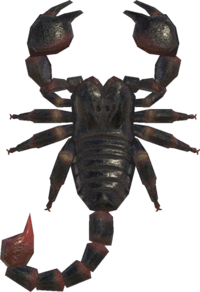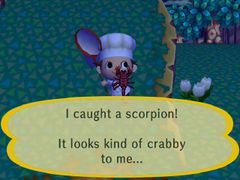Scorpion
- "I caught a scorpion, but it didn't catch me!" —Wild World
- "I caught a scorpion! It looks kind of crabby to me..." —City Folk
- "I caught a scorpion! Not so fast now, are ya?!" —New Leaf
- "I caught a scorpion! It was a sting operation!" —New Horizons
The scorpion (サソリ, sasori) is a rare bug that can be found on the ground anywhere in town from 7 p.m. to 4 a.m.. It can be sold for 8,000 Bells. Like the Tarantula and Bee, they are hard to catch as well as harmful, but will only attack a player if they are holding a net. Also, unlike the Bee, the Scorpion does not leave a noticeable wound on the player. If startled by rapid movement (whilst holding the net), it will sting the player, which causes the player to faint and re-awaken outside of their home, though with no other status effects upon awakening.
Catching the scorpion
The Scorpion is a harmful insect, meaning that it can cause damage in some way to the player. In this case, if players take out their net or have their net equipped when nearby, it will chase after them, running just as fast as the player's top speed. If it stings them, it knocks them out, forcing them to re-appear in front of their house. The only way to avoid getting stung once provoked is to enter a building or to catch it. The player will scare any villagers talked to while being chased, and the villager will make a comment about getting away from them before the Scorpion catches up and stings the player. The Scorpion can jump off of cliffs, jump over small walls (like those of a ramp as it slopes down), and walk over holes.
To catch the Scorpion, players must slowly sneak up on it. If the net is equipped, it will not run away from the player, even if it is staring directly at them. A good tell that the Scorpion has seen the player is its tail; the tail will curl forward and shake, ready to strike if the player gets too close or spooks the creature with a careless net swing. Unlike the Tarantula, the Scorpion's small size and light brown/red color scheme makes it difficult to notice if the player is not paying attention, especially on patches of bare dirt, so the player must stay alert during the time the Scorpion appears.
Donation to the museum
In Wild World
Upon donation of the Scorpion to the museum, Blathers the curator will say the following:
"I've heard that a scorpion can be affected by its own poison, you know. If so, why carry around such dangerous material? Blech! Foolish wretch... If I walked around with a piano above my head, I'd expect to be squashed, wot!"
After donation, the Scorpion can be found on the second tier of the museum, in the same enclosure as the Tarantula. The Scorpion and Tarantula can be seen battling with each other when both have been donated. The Scorpion can be seen shaking its stinger at the Tarantula (once donated), which makes a rattling noise. The Tarantula can be heard making a hissing-type noise in return, which might be associated with the insect's defense mechanism of scratching hairs at enemies. They will circle each other, and eventually, both jump into the air and collide, then begin their battle again. If the Scorpion is donated on its own without the Tarantula, it will be aware of the player's presence and shake its stinger at them instead, but never attacking. If the player has the net equipped when walking in the museum (although it is not visible), sometimes the Scorpion will lunge out of its area and charge at the player.
In City Folk
Upon donation to the Museum, Blathers the curator will say the following:
"...Scorpions are assuredly attention getters. They've got those colors that say, "Stay back! I'm poisonous!" However, it seems only a tiny group of scorpions have venom lethal enough to off you with one sting. Mischievous scorpions that look like highly poisonous ones probably fooled folks into thinking otherwise."
In New Leaf
Upon donation to the Museum, Blathers will place this description in the insect exhibit:
"Scorpions resemble crabs and are in the class arachnida, though they aren't aquatic. Most species possess venom, but of the 1,000 or more species, only 25 are deadly to humans. Scorpion eggs hatch inside the females abdomen, and the young spend time on her back after birth."
In New Horizons
"The scorpion...how should I put this? Those legs! Those pincers! That tail! And that venomous stinger! It's as if someone took all the most awful insect parts...and put them together to make the scorpion! All scorpions are venomous, you know! Though I understand that only a few kinds are truly deadly. I feel I might die just thinking about it."
When donated, it is found in the large desert sand tank in the back room of the bug exhibit, next to the tarantula tank.
Encyclopedia information
Wild World
''Their "tail" is actually part of their stomach."
|
City Folk
Further information
Scorpions belong in Arachnida class, which also includes spiders and ticks. Unlike most arachnids, scorpions are ovoviviparous, which means scorpions hatch eggs inside their bodies while their young are born live. Then, the young depend on their mother by riding her until their first molt. Scorpions are found in a variety of landscapes, except for the tundra, in all continents except for Antarctica. Although scorpions are feared generally, only 25 out of over 1700 known species can produce potent enough venom to kill humans. Scorpions are nocturnal, hence why they are found only during the later hours of the day in Animal Crossing. Scorpions are known to consume massive amounts of food in one sitting, and they have low metabolism. Despite this, they can consume only liquids.
Names in other languages
| 전갈 jeon-gal |
Scorpion | |
| 蝎子 xiēzi |
Scorpion | |
| 蠍子 Unknown |
||
| Скорпион Skorpion |
Scorpion | |
| Schorpioen | Scorpion | |
| Skorpion | Scorpion | |
| Escorpión | Scorpion | |
| Scorpion | Scorpion | |
| Scorpione | Scorpion | |
| Bugs | ||||||||||||||||||||||||||
|---|---|---|---|---|---|---|---|---|---|---|---|---|---|---|---|---|---|---|---|---|---|---|---|---|---|---|
| ||||||||||||||||||||||||||

